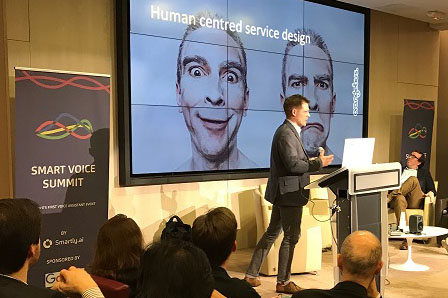Is it Time for Enterprise Voice Assistant Adoption in Europe?
Orange Bus AI specialist, Dan Whaley, and Innovations Consultant, Steve Molesworth, recently attended the Smart Voice Summit in Paris, Europe’s first official voice assistant event. It may seem to be early days for this kind of technology, but is now the time for enterprise size businesses to grab hold of the voice revolution?
Since launch, the growth rate in consumer demand for smart speakers has been pretty phenomenal. According to Forrester in just a few years since launch, 20% of US households currently have a smart speaker, and if the forecasts are correct, 40% of US and UK households will have one be 2020.
Research by Capgemini predicts that an actual preference for voice-based interactions over traditional websites or apps will grow rapidly in the next 3 years from 24% now to 40% by 2020; they also suggest that the appetite for voice assistants instead of physical outlets like banks and shops will grow from 20% now to 31% in 3 years.

These numbers present a phenomenal opportunity for brands to reach their customers, but is now the right time to create a strategy for voice? And, if so, what should this look like?
Don’t Delay, Voice is Now
One of the core messages from our trip to the Paris conference – impressively put together by Smartly.ai – was that this is still absolutely ‘day one’ in voice assistant adoption in Europe. But, as with all consumer technology revolutions, there is clear advantage to getting-in on the ground floor. With voice, the benefits of early exploration are even more pronounced.
Conversational technologies require significant refining and adaptation based on observing users. Being an early entrant in this market gives your brand a significant advantage in honing your voice app to your customers before your competitors. As consumer adoption grows, not being present in voice closes you off from a significant and intimate touch point. As Bret Kinsella of Voicebot.ai put it at Smart Voice Summit:
If you aren’t present, your brand is literally silent.
However, we need to be aware of and work within, the limitations or preferences of the current technology and its users. According to the Capgemini study, consumers are typically most comfortable using smart speakers within the home and specifically the kitchen (61%) or living room (69%). They also frequently cite speed of use and hands-free interaction as key reasons for use. As Tom Hewitson from Labworks.io put it: “
Voice is the ultimate lean back experience.
The technology is also limited in ability to engage in meaningful conversation, restricted in reality to answering only a couple of questions before serving content or completing a task. This means there are many core use cases that are simply not suited to voice alone. How quickly your organisation should embrace voice will depend to some extent on the sector you are in, and therefore how much your typical customers’ everyday actions make sense for voice. At the conference we heard from a number of industry leaders about their voice strategies.

Media Companies
For media companies, especially radio, it’s pretty cut and dried. Voice is a great addition to your digital experience so you really need to be getting your content into the right format and sorting out the voice UI. We heard from the Financial Times, the BBC and Radio France, all of whom have advanced voice apps across multiple platforms and are ramping up engagement.
Transport and Logistics
Voice looks like a good fit for transportation and logistics. Users often want quick ‘in life’ updates to journey times or to book or arrange regular trips. Vehicle manufacturers are lining up to add voice assistants to in-car experiences, growing the accessible market. Transport providers such as National Rail (UK), SNCF (France) and Uber are already present and adding capability. For logistics, getting updates or modifying a delivery is again well suited. It’s clearly time to embrace voice.
Retail
The case for retail is less clear. If you are a provider of routine purchases such as groceries or basic household items, voice makes perfect sense. Users are in the home, at a point of need and want a friction free means to add, say teabags, to their shopping list. For less routine or higher value purchases, the likelihood of a satisfactory experience purchasing by voice or involving a voice touch point seems less apparent.
Capgemini report 52% of respondents interested in purchasing electronics and 46% clothes via voice, but I think this requires further research and validation. Diary studies conducted by Orange Bus, interviewing users about their interactions with Alexa in their home, show much less inclination to make these types of purchases without seeing and getting further information about the item.
Financial Services
Many of your customers’ top tasks such as checking a balance, making a payment to a regular payee or transferring funds make perfect sense. These simple services have also been well tested in voice user interfaces on the phone over many years. However, there is a clear issue with privacy and data security in the current generation of voice assistants, which customers often cite this as a significant concern. Financial service providers may be wise to wait until security add-ons like biometrics allay these concerns, and consumers get used to having Google or Amazon as an intermediary within the realm of personal finance.

Where to Start
Across most industries, although there may be current restrictions, it seems clear that voice is becoming a key touchpoint and brands need to integrate it into their service design strategy, but where to start? A clear message from the conference, delivered eloquently by Karen Kaushansky (@kjkausha), was that we need to think wider than just voice and design for multi-user, multi-device and multi-modal experiences.
Although this may feel like a distant prospect, this is what we should be aiming for, and it may be closer than we think. A Google executive pointed out their assistant is currently accessible on over 400 million devices from phones and speakers to cars and refrigerators. We also need to aim big but start small – setting the grand strategy then working through small and agile projects, learning as we go.
 As Principal Solution Manager for Digital, Dan Whaley is responsible for a range of Digital Self-Service solutions including speech technologies, IVR, biometrics, virtual assistants and digital engagement. He is serves as an AI consultant for Orange Bus. Previously a Senior UX Consultant, he has over 15 years academic and industry experience in AI, speech and cognitive science. Orange Bus has recently expanded its Futures team to include focus on AI and voice interactions.
As Principal Solution Manager for Digital, Dan Whaley is responsible for a range of Digital Self-Service solutions including speech technologies, IVR, biometrics, virtual assistants and digital engagement. He is serves as an AI consultant for Orange Bus. Previously a Senior UX Consultant, he has over 15 years academic and industry experience in AI, speech and cognitive science. Orange Bus has recently expanded its Futures team to include focus on AI and voice interactions.
Amazon Echo is Now Shipping to Ireland – How You Can Tell Who Might Get Alexa Localization Next









